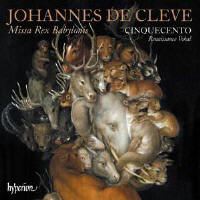Texte paru dans: / Appeared in:
|
|
|
Outil de traduction ~ (Très approximatif) |
|
|
Reviewer: J.
F. Weber
Another obscure Renaissance
composer receives his due from Cinquecento, one of two ensembles on the
Hyperion label that have expanded the record catalog listings for this
period. Johannes de Cleve (1528/29–82) did earn a spot in the Fanfare
Archive with two selections in a collection titled Renaissance am Rhein
(Fanfare 34:5), the motet Mirabilia testimonia tua, Domine for six voices
and the same vernacular hymn heard on the new disc. Now for the first time
we can hear a sizable selection of his music.
It is not certain that Cleve
was born in the city of Cleves (remember Henry VIII’s fourth wife) or even
that he spent his formative years in the Low Countries, but he joined a lot
of Franco-Flemish musicians in the Hapsburg chapel in Vienna in 1553, where
Jacobus Vaet was serving. Cinquecento has devoted a whole CD to Vaet (32:6),
as well as parts of two others (30:6 and 38:3). In 32:6 I mentioned three
more Vaet CDs directed by Eckehard Kiem, and he completed his survey with a
fourth CD of ten sacred works, all four discs reissued in a boxed set on
Brilliant (40:3).
The major work on the program
is a Mass based on Vaet’s motet published in 1568, with the motet added at
the end of the program. It is quite remarkable for an unknown work, its
thematic unity being derived from the parody technique using Vaet’s motet.
The notes point out just one example of Vaet’s way with his model. The motet
begins with a rising minor sixth in two voices and a rising fifth in the
other three. In the Gloria Cleve uses the rising minor sixth in all voices
except the bass, which retains the rising fifth. A more extended analysis of
this sort would have been welcome. The half-hour Mass is all in five voices
except sections in the Credo and in the Sanctus for four voices. Cleve’s part of the program begins and ends with five-voice secular motets honoring two Karls. The motets are united by the falling fifth that opens each and the subjects are united by given name and Hapsburg lineage. The first motet is dedicated to Archduke Charles, the youngest son of Ferdinand I, whom Cleve served after the emperor’s death in 1564. The other is an epitaph for the death at the age of 19 of Karl Friedrich of Jülich-Cleves-Berg, son of Maria, the daughter of the emperor. (He died of smallpox in Rome.)
Es wel uns Gott, the
five-voice setting of Luther’s paraphrase of Psalm 67, is the only
vernacular piece in Cleve’s Cantiones (1579), noted above as previously
recorded. Annotators offer opposite speculations about Cleve’s choice to set
the text. The earlier idea was Cleve’s possible flirting with Protestantism.
This note suggests that his reason was “to support the Lutheran message or
subvert it … or for some other reason,” covering all the bases. It is
followed by the brief Psalm 116 and the gradual and alleluia verse for All
Saints’ Day, taken from Psalm 33. Credo quod redemptor meus comes from Job
19:25–27 (a text best known from its use in Messiah), in this instance a
responsory from the Office for the Dead.
Vaet’s motet on which the Mass
is based sets the text from Daniel 14:39–42 (the last lines of the book in
the Vulgate text), the moment when the king of Babylon arrives at the lions’
den to find Daniel sitting in their midst, and he then announces the
greatness of Daniel’s God. This effective work must be a first recording.
The five voices weave around without obscuring the flow of text. With this issue Hyperion has given us a dozen discs, almost one per year, of 16th-century polyphony sung by five men from across Western Europe. Formed in 2004 as a group of six voices, this is their third program as a group of five voices, still retaining four of the original members. They have sung a polyphonic Mass every Sunday since 2005 at a church in Vienna, distinguishing them from groups who get together just long enough to make a recording. Their focus is on the Hapsburg court in the mid-16th century and the mostly obscure composers who served there. One disc each for Willaert, Lassus, and Palestrina are the most notable departures from this concentration. The voices are strong and firm, the blending exquisite. They have used several Viennese churches to obtain a warm sound while capturing the voices up close. The Mass that Cleve fashioned around Vaet’s motet is a remarkable discovery, ranking with Guyot’s Te Deum laudamus (41:1) and Palestrina’s unrecorded Book 2 of Lamentations (43:3) as special gifts for which we must be grateful.
There are a
few other vocal ensembles that sing one voice to a part, outnumbered by the
two-voices-per-part groups, not to mention some fine larger ensembles and
even choirs that have been recording music before 1600 very effectively. But
Cinquecento is special for its rare repertoire, its choice of programming on
each disc, and its vocal quality. If you have not encountered this group,
Johannes de Cleve is a good place to start.
| |
|
|
|
|
Cliquez l'un ou l'autre
bouton pour découvrir bien d'autres critiques de CD |
|




